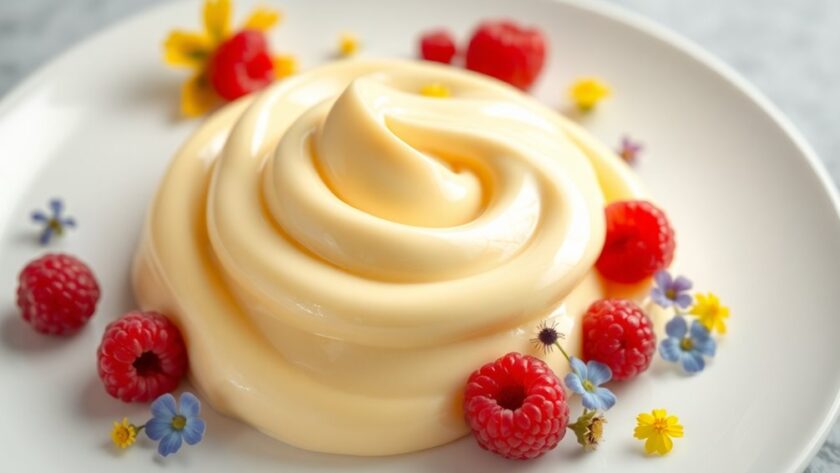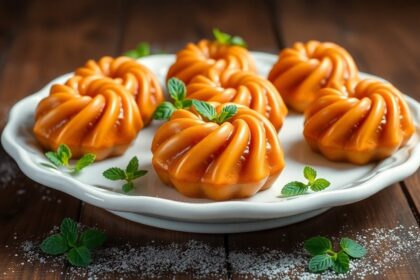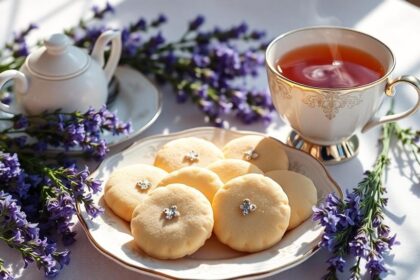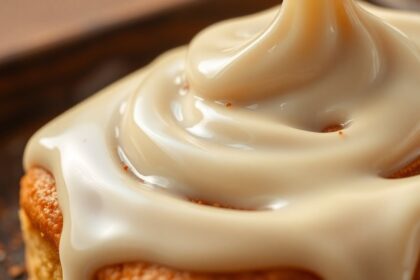Mastering Crème Mousseline is your ticket to exquisite French pastries. This rich filling blends pastry cream and whipped butter in a 2:1 ratio for the perfect texture. You'll need quality ingredients like whole milk, egg yolks, and vanilla, with careful cooking techniques to avoid curdling. Remember to whisk continuously and keep your butter at the right temperature. Whether you're filling éclairs or enhancing layered cakes, Crème Mousseline impresses with its creamy consistency and versatility. With a few tips and tricks, you'll soon create desserts that wow your guests—there's always more to discover about this classic culinary delight!
What Is Crème Mousseline?
Crème Mousseline is a deliciously rich custard-based filling that combines pastry cream with whipped butter, creating a light and silky texture. This classic French pastry filling typically follows a ratio of 2 parts pastry cream to 1 part whipped butter, guaranteeing a creamy texture while providing stability in your desserts.
You'll love its versatility, as Crème Mousseline works wonders as a filling or frosting for various pastries like éclairs, cream puffs, and layered cakes.
One of the best aspects of Crème Mousseline is its potential for flavor enhancement. You can infuse it with vanilla, chocolate, or fruit purees, allowing for a wide array of culinary applications. The incorporation of flavors can be similar to adding melted dark chocolate to a mousse base, enhancing both depth and richness.
To achieve that silky smooth consistency, it's essential to prepare both the pastry cream and the whipped butter at the right temperatures; this prevents curdling and guarantees a seamless blend.
Whether you're a seasoned baker or just starting, mastering Crème Mousseline will elevate your pastry game. Its rich flavor and luxurious texture will impress your family and friends, making it a must-have in your culinary repertoire.
Enjoy creating delightful treats with this exquisite filling!
Key Ingredients
To create a delicious Crème Mousseline, you'll need a few key ingredients that come together to form its rich and smooth texture. Start with 2 ½ cups of whole milk, which serves as the base for your thick pastry cream. The importance of using high-quality ingredients cannot be overstated, as they significantly enhance the final product. The use of espresso-infused sponge cake in desserts can also complement the flavors of Crème Mousseline beautifully.
You'll also need 5 large egg yolks and 3 tablespoons of cornstarch, both of which help thicken the pastry cream, ensuring it reaches that luscious consistency.
Don't forget the ½ cup of superfine sugar to add sweetness. Unsalted butter is essential, typically used at a ratio of 1 part butter to 2 parts pastry cream. High-quality unsalted butter enhances the flavor and texture of your Crème Mousseline, making it a rich filling for your French pastry creations.
To elevate the flavor profile, include 2 teaspoons of vanilla extract, which pairs beautifully with the creaminess.
For best results, heat the whole milk to around 175°F (79°C) to activate the cornstarch, ensuring proper thickening without scrambling the eggs. Additionally, incorporating coffee buttercream as a filling can elevate your pastry to a new level of indulgence.
With these key ingredients in hand, you're well on your way to mastering this classic French pastry cream!
Cooking Techniques
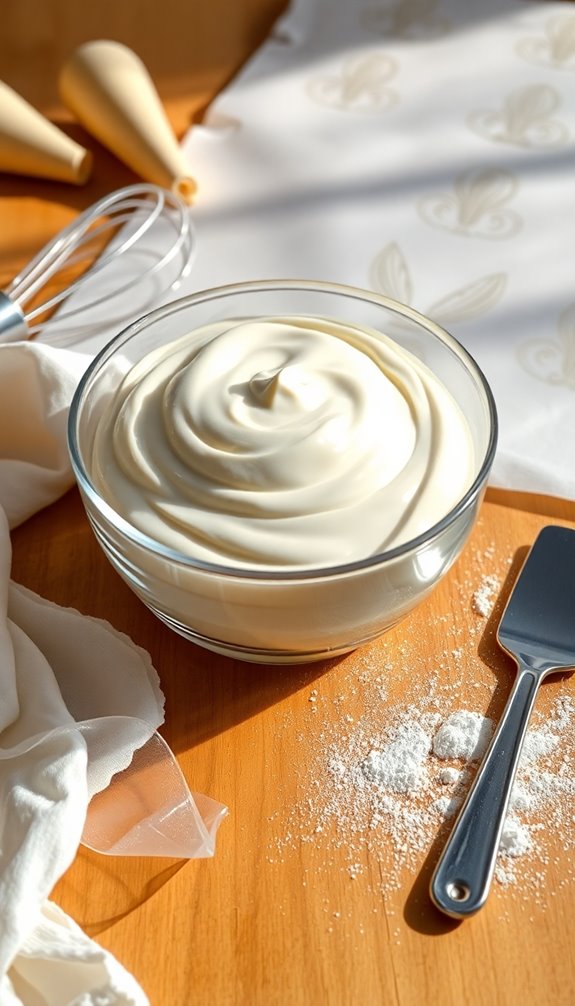
Mastering the cooking techniques for Crème Mousseline is vital for achieving that smooth, velvety texture. Start by heating your milk until it reaches a gentle simmer—never let it boil, as this can cause the egg yolks to scramble. While whisking continuously, combine the hot milk with the egg yolks to create a smooth, lump-free pastry cream. This constant motion helps the mixture thicken evenly, preventing any undesirable clumps. Additionally, precise tempering techniques ensure that the egg yolks integrate smoothly without curdling. The use of high moisture content in the initial mixture also contributes to the cream's richness.
Once your pastry cream is cooked, it's important to strain it through a fine-mesh sieve. This step removes any potential lumps and guarantees a silky texture. To avoid forming a skin as it cools, immediately cover the surface with cling wrap, making sure it touches the cream directly.
When you're ready to incorporate the butter, make sure it's at room temperature. Whip it until creamy and then fold it into the cooled pastry cream. This will give your Crème Mousseline that light and airy texture you're after. Additionally, the process of tempering egg yolks is crucial to prevent curdling and ensure a smooth consistency in your cream.
Making Crème Mousseline
To make Crème Mousseline, you'll need a few key ingredients like whole milk, egg yolks, and unsalted butter. The history of cheesecake's evolution showcases the importance of mastering traditional recipes, much like creating the perfect pastry cream. Once you gather these essentials, follow a step-by-step process to prepare the pastry cream and mix in the butter for that perfect texture. The technique of making French buttercream is crucial to achieving a creamy, smooth consistency that elevates your desserts. Additionally, understanding the significance of French culinary artistry can inspire you to enhance your pastry skills and creativity in dessert making.
Essential Ingredients Overview
Creating a delicious Crème Mousseline hinges on a few essential ingredients that work together to achieve its signature smooth and creamy texture.
First, whole milk provides the richness necessary for a luscious pastry cream, while granulated sugar adds sweetness and helps stabilize the mixture during cooking. You'll need large egg yolks to contribute flavor, richness, and a beautiful golden color; ideally, use four to six yolks for every two cups of milk to perfect the texture.
Cornstarch acts as the thickening agent, with about three tablespoons recommended for that smooth consistency without heaviness.
Next, high-quality unsalted butter is vital for integrating into your cooled pastry cream. A standard ratio of two parts pastry cream to one part butter yields a lighter texture, while a 1:1 ratio will give you a firmer consistency.
Finally, don't forget the vanilla extract or vanilla bean paste. Adding two teaspoons enhances the flavor profile beautifully, ensuring your Crème Mousseline isn't just rich and thick but also irresistibly delicious.
With these ingredients in hand, you're well on your way to mastering this classic French pastry cream!
Step-by-Step Preparation Techniques
When preparing Crème Mousseline, it's essential to follow a clear sequence of steps to guarantee a smooth and creamy result. Here's how to make it:
1. Heat Milk: In a saucepan, heat 2 ½ cups of whole milk and 2 teaspoons of vanilla extract until steaming.
2. Mix Egg Yolk Mixture: In a separate bowl, whisk together 5 large egg yolks, ½ cup of superfine sugar, 3 tablespoons of cornstarch, and 1.5 tablespoons of all-purpose flour until smooth.
3. Temper and Cook: Gradually add the hot milk to the egg yolk mixture while whisking continuously to prevent scrambling.
Return the mixture to the saucepan and cook over medium heat, whisking continuously until it thickens into a custard, about 2-3 minutes. Strain the pastry cream through a fine mesh sieve and cool it at room temperature, covering with cling wrap to avoid a skin.
4. Whip Butter: In a bowl, whip 1 cup of softened unsalted butter on high speed until pale. Gradually add the cooled pastry cream one tablespoon at a time, whipping on medium speed until combined.
Store your Crème Mousseline in an airtight container in the refrigerator for up to 4 days.
Troubleshooting Tips
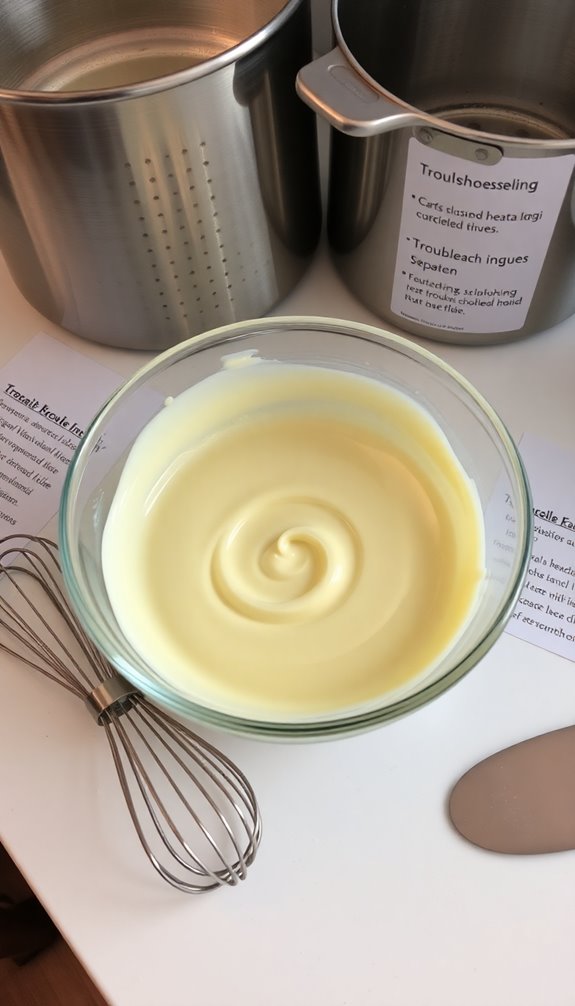
When you're working on your crème mousseline, you might run into some common texture issues or temperature mishaps.
If your cream isn't coming together as expected, it's crucial to know how to troubleshoot these problems effectively. For instance, incorporating contrasting textures can elevate the overall experience and may help mask minor inconsistencies in your cream's texture. Additionally, a well-crafted chocolate chip cookie can serve as a delightful accompaniment, enhancing the overall dessert experience.
Let's explore some tips to guarantee you achieve that perfect consistency every time. Additionally, understanding the importance of high-quality chocolate can significantly enhance the flavor profile of your pastry cream.
Common Texture Issues
Crème mousseline's texture can often be a source of frustration, but understanding common issues can help you achieve that perfect consistency. Here are some troubleshooting tips to keep in mind:
- Too Soft: If your mousseline is too soft, refrigerate the mixing bowl to firm it up. This can help stabilize the cream.
- Over-Fluffed: For over-whipped cream, gently melt excess air by placing the bowl in a warm water bath. This can restore a smoother texture.
- Temperature Monitoring: Always monitor the temperatures of both butter and pastry cream closely. Using cold ingredients can lead to curdling and an inconsistent texture, so aim for the butter at 68-70°F for an airy texture or 72-75°F for a denser consistency.
- Avoid Over-Whipping: Be cautious not to over-whip the mixture, as this can result in grainy or separated cream. Whip just until smooth and fully incorporated.
For best results, store your crème mousseline in an air-tight container in the refrigerator.
Consume it within four days to maintain ideal texture and flavor. With these tips, you'll master the perfect mousseline!
Temperature Control Tips
Temperature control is essential for achieving the perfect crème mousseline. Start by maintaining your butter temperature between 68-70°F for an airy texture when incorporating it into chilled pastry cream. If your butter's too warm (72-75°F), the mixture will yield a denser consistency, affecting the overall texture.
Keep a close eye on your pastry cream's temperature; if it exceeds 175°F (79°C), it can curdle or thicken too much, ruining the final product. If your cream becomes too soft while mixing, simply place the mixing bowl in the refrigerator for a short period to firm it up before you continue whipping.
In case you accidentally over-whip your crème mousseline, don't panic. You can gently warm the bowl in a warm water bath to melt excess air and restore creaminess without compromising texture.
Finally, always use weight measurements for both butter and pastry cream to guarantee consistent results and prevent issues related to temperature fluctuations. Following these tips will help you maintain the right temperature and achieve a perfect crème mousseline every time.
Storage Recommendations
To keep your crème mousseline fresh and delicious, store it in an airtight container in the refrigerator. This method helps maintain freshness and prevents it from absorbing odors. Here are some essential storage recommendations:
- Consume within 4 days: For the best flavor and texture, aim to use your crème mousseline within this timeframe. Cookies made with gluten-free flour can also be enjoyed within a similar period for optimal taste.
- Cover to prevent a skin: To avoid the formation of a skin on the surface, press plastic wrap directly against the cream before sealing the container.
- Thaw in the refrigerator: If you decide to freeze your crème mousseline, it can last up to 3 months. Be sure to thaw it slowly in the refrigerator to preserve its texture.
- Re-whipping before use: After refrigeration or freezing, you might need to re-whip the crème mousseline to restore its light and airy texture.
Additionally, consider using nutrient-rich ingredients in your desserts to enhance flavor and health benefits. If you've made a whole dessert with crème mousseline, remember to refrigerate it and consume it within 5 days for peak quality.
Following these tips will help you enjoy your crème mousseline at its best!
Culinary Applications
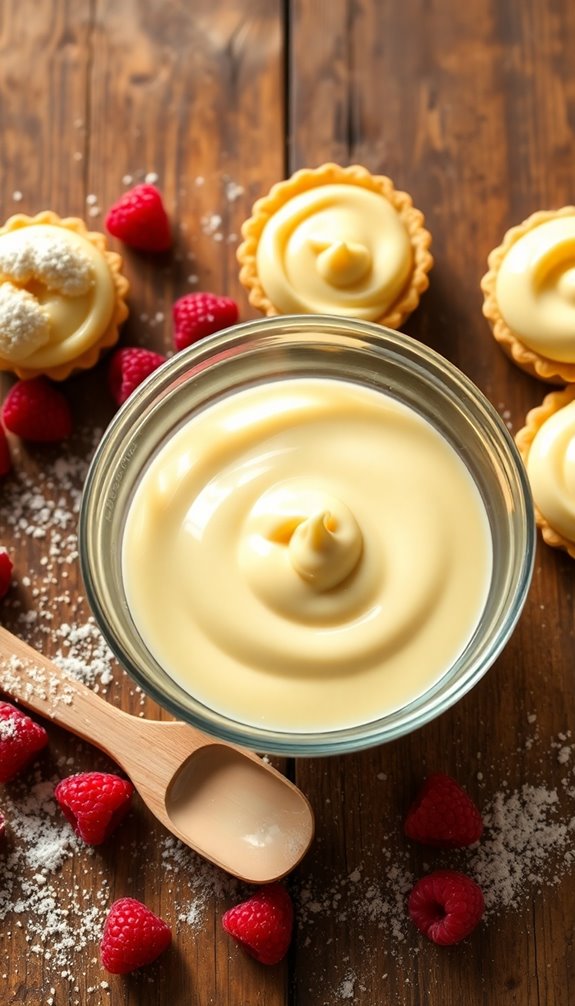
Versatility defines crème mousseline, making it a favorite in the pastry chef's repertoire.
You'll find this rich and creamy French pastry cream used as a filling in delicate pastries like éclairs, cream puffs, and the classic Paris-Brest. Its luxurious texture elevates these treats, providing a satisfying bite.
Beyond pastries, crème mousseline shines as a less sweet alternative to traditional buttercream for layered cakes. This keeps the flavor profiles balanced while ensuring structural integrity.
You can also pipe it into tart shells, enhancing fruit tarts and custard tarts.
Conclusion
In mastering crème mousseline, you're not just whipping up a pastry cream; you're crafting a velvety cloud that elevates your desserts to celestial heights. With each silky spoonful, you invite sweetness and sophistication into your creations. Remember, practice makes perfect, so don't shy away from experimenting. Store it wisely, troubleshoot with confidence, and let your culinary imagination run wild. Soon, you'll find yourself dancing through the world of French pastries, leaving a trail of delight behind.

